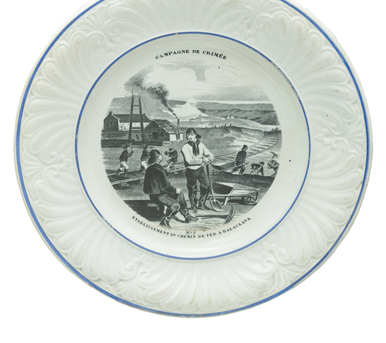The battle of Alma on September 8, 1854 was the first major battle of the Crimean War. It took place between Russia and the troops of Great Britain, France and Turkey that landed in the Crimea.
The battle took place on the Alma River, from which it got its name. In Crimean Tatar, the word “alma” means “apple”: at that time, apple orchards grew on both banks of the river.
The battle began at about noon and lasted five hours. The Russian army was initially in an advantageous position, despite its smaller incidence. However, the command did not have a clear plan of action, so the battle ended with the retreat of the Russian troops. In this battle, they lost more than 6,000 people. But the Russian army was able to stop the advance of the allied troops to Sevastopol, prevent the assault on the city, which was left without troops, and buy time. This made it possible to prepare for the defense of Sevastopol, which lasted 349 days.
The decorative plate depicting the Battle of Alma was made in the 1860s in France. It is made of faience and coated with white glaze for durability.
The image on the bottom of the plate is in black and white. The background shows a hilly landscape covered with gunpowder smoke. On the left, the factory craftsmen depicted the French troops on the offensive: with rifles in hand, they are going into a bayonet attack. An officer with a saber and a banner in his hands leads them into battle. On the right side of the plate Russian soldiers in greatcoats and helmets are painted. They are firing back at the French. At the top of the piece there is an inscription in French Campagne de Crimee — “Crimean Campaign”. And at the bottom of the plate is the signature No. 2 Bataille de l’Alma, which translates as " Battle of Alma.” A floral ornament and a thin blue border adorn the edges of the piece.
The battle took place on the Alma River, from which it got its name. In Crimean Tatar, the word “alma” means “apple”: at that time, apple orchards grew on both banks of the river.
The battle began at about noon and lasted five hours. The Russian army was initially in an advantageous position, despite its smaller incidence. However, the command did not have a clear plan of action, so the battle ended with the retreat of the Russian troops. In this battle, they lost more than 6,000 people. But the Russian army was able to stop the advance of the allied troops to Sevastopol, prevent the assault on the city, which was left without troops, and buy time. This made it possible to prepare for the defense of Sevastopol, which lasted 349 days.
The decorative plate depicting the Battle of Alma was made in the 1860s in France. It is made of faience and coated with white glaze for durability.
The image on the bottom of the plate is in black and white. The background shows a hilly landscape covered with gunpowder smoke. On the left, the factory craftsmen depicted the French troops on the offensive: with rifles in hand, they are going into a bayonet attack. An officer with a saber and a banner in his hands leads them into battle. On the right side of the plate Russian soldiers in greatcoats and helmets are painted. They are firing back at the French. At the top of the piece there is an inscription in French Campagne de Crimee — “Crimean Campaign”. And at the bottom of the plate is the signature No. 2 Bataille de l’Alma, which translates as " Battle of Alma.” A floral ornament and a thin blue border adorn the edges of the piece.
The plate is part of a series of dishes depicting significant events during the Crimean War. It was made by the French manufacturer of faience products “Creil and Montero”. In 1840, under this common name, two porcelain and faience enterprises were united. So, they were called until the beginning of the 20th century. The company “Creil et Montereau” was considered one of the best, and the porcelain and faience products produced at it, received awards at various exhibitions more than once.



